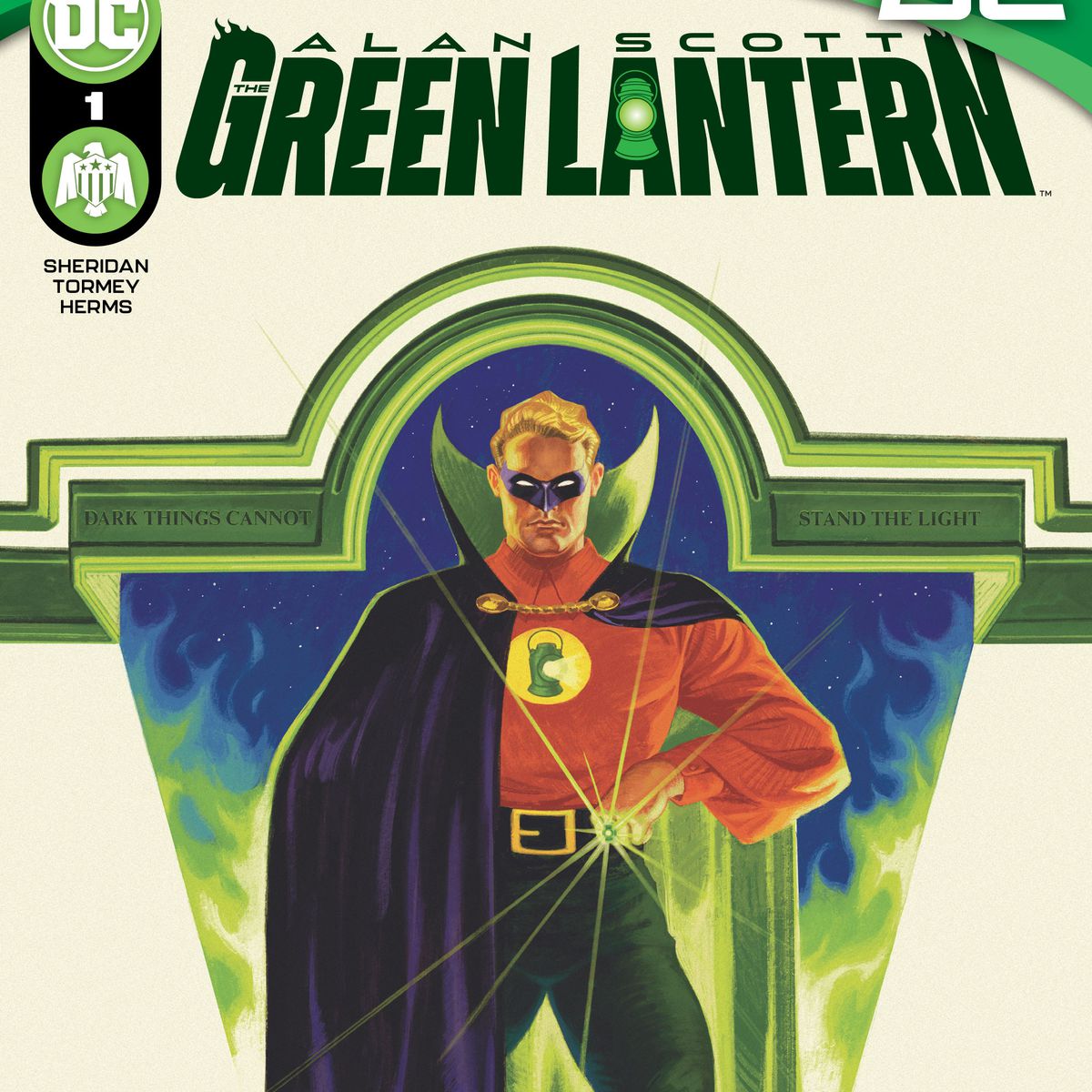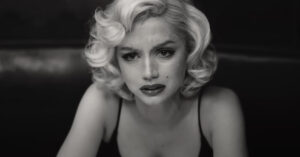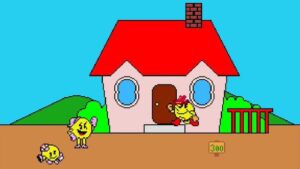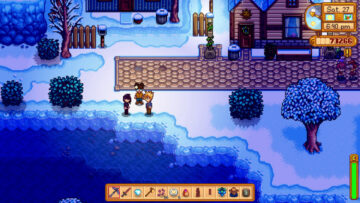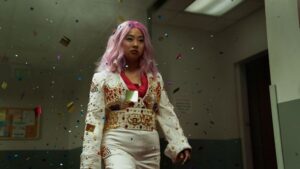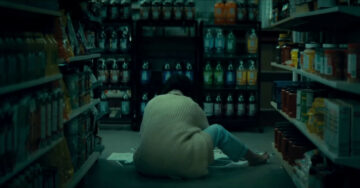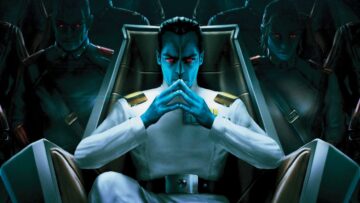It’s common for comic book creators to get on social media and rally fans to buy their newest book. But writer Tim Sheridan — whose credits include Teen Titans Academy, Dragon Age: Absolution, and as of this week, DC Comics’ six-issue miniseries Alan Scott: The Green Lantern — had something a little different to say last week.
In a video posted on X (formerly known as Twitter), Sheridan asked fans for “a favor” when it came to The Green Lantern, saying “already the haters and the queer-phobes are out in force, doing everything they can to see that this book tanks. They use code and they make it sound like they have legit problems with a book they haven’t read yet, but the truth is they just don’t like that there’s a queer hero in the upper ranks of the DCU.” In response, Sheridan announced he was asking queer and open-minded fans to pick up copies of the series, written by him and drawn by Cian Tormey — and would be donating all of his royalties to the Elton John AIDS Foundation.
“[Green Lantern] is the first time I, an out queer writer, have told a story with a lead character who’s gay,” Sheridan told Polygon via email. As the original Green Lantern, Alan Scott was one of DC’s earliest superheroes. The idea of evolving the character towards queerness has been percolating since 2012, and he came out of the closet in a 2020 story written by James Tynion IV and drawn by Stephen Byrne.
“To be honest, I was not sure I would accept the assignment when it was offered,” Sheridan said, “and that’s because of the experiences I’ve had with bigots, mostly on social media, working to sabotage the success of projects that feature diverse characters and/or diverse creators, all in furtherance of their hateful and, as I see it, dumb, agenda. So I’m no stranger to this type of bullying but, for a long time, I tried to ignore it for fear of fueling a fire I didn’t start. Fast forward to last week. Our book has been attacked since its announcement and with the release of the preview pages last week, the attacks began growing exponentially. I saw that and, knowing it would continue to fester if left unchecked, I reexamined my fire-fueling policy and tried to turn it into a firefighting policy.”
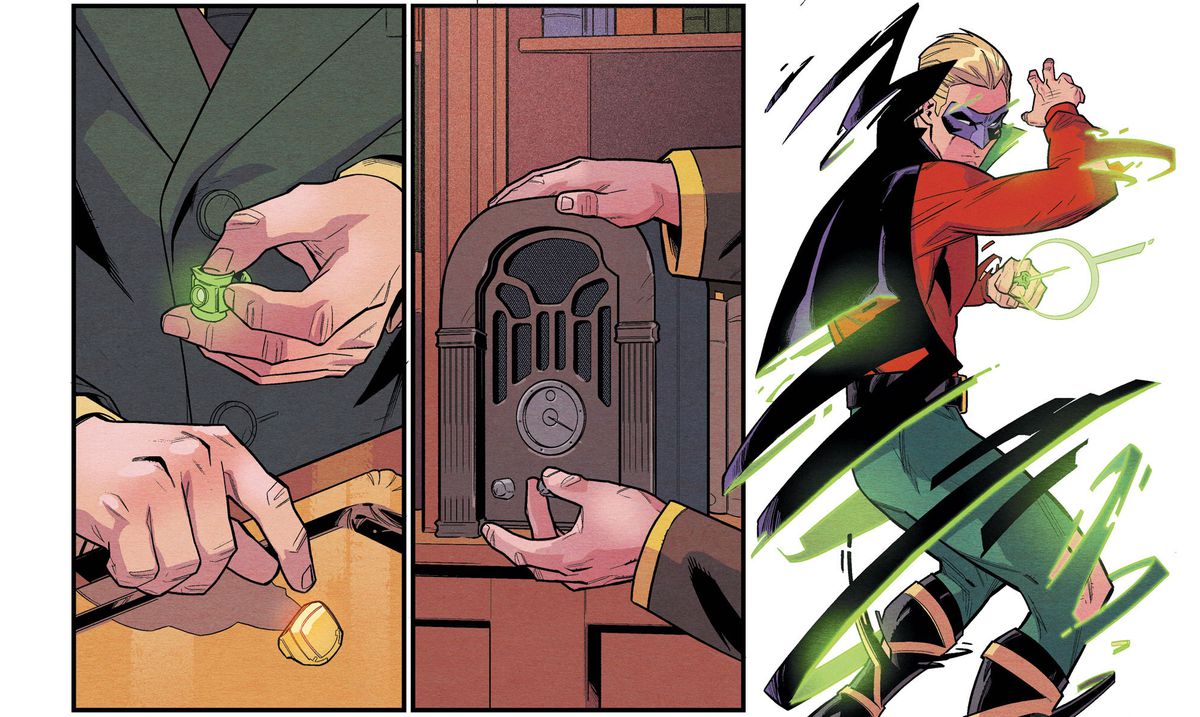
But if he was going to ask fans to “buy the heck out of this book” for reasons beyond their own personal enjoyment, Sheridan said, he felt he had to remove his own gain from the equation. “The sad truth about comics is that you don’t make a lot of money making them (in fact, sometimes you make no money at all.) But the great thing about companies like DC is that they offer royalty participation so that we can share in the success of the work we’ve created. […] It was an easy decision to pledge to donate 100% of my royalties from these six issues to charity.”
Sheridan says he chose the Elton John AIDS Foundation because he’s felt inspired by the singer-songwriter’s work and philanthropy for a very long time. And he was effusive when talking about it, citing the high percentage of the contributions to the organization that goes to those in need, and its attention to supporting a combination of research into a cure, treatment/support of those living with HIV/AIDS, and palliative care. “As someone who has known too many people affected by AIDS, it has, from its inception, been my charity of choice.”
“I’m no hero,” Sheridan said, “but since I write about them, I think I’m correct when I say [donating royalties is] the thing Alan Scott would do!”
The Green Lantern was created by Martin Nodell and Batman co-creator Bill Finger in 1940, making him one of DC Comics’ oldest superheroes — and Alan Scott is one of its newest openly gay ones. While an alternate-reality version of him was depicted as an openly gay man in 2012’s Earth 2, that wouldn’t be incorporated into the main DC universe until 2021’s Infinite Frontier #0, when Alan revealed to his children — the superheroes Jade and Obsidian — that their own struggles had inspired him to live openly and truthfully, coming out to them as gay.
Sliding timescales, multiverse shenanigans, and other superhero science fiction allow Alan Scott to be a relatively sprightly silver fox in modern times, despite being around to found the Justice Society of America in the postwar era. Polygon got a chance to take a look at the first two issues of Alan Scott: The Green Lantern, and Sheridan tells a story that bridges Scott’s pre-superhero life as a military engineer and his early days as part of the Justice Society, with the Green Lantern confronting a killer whose acts harken back to one of the darkest times in his life, after the death of his first love. In both periods, Scott is carefully closeted, even from other superheroes.
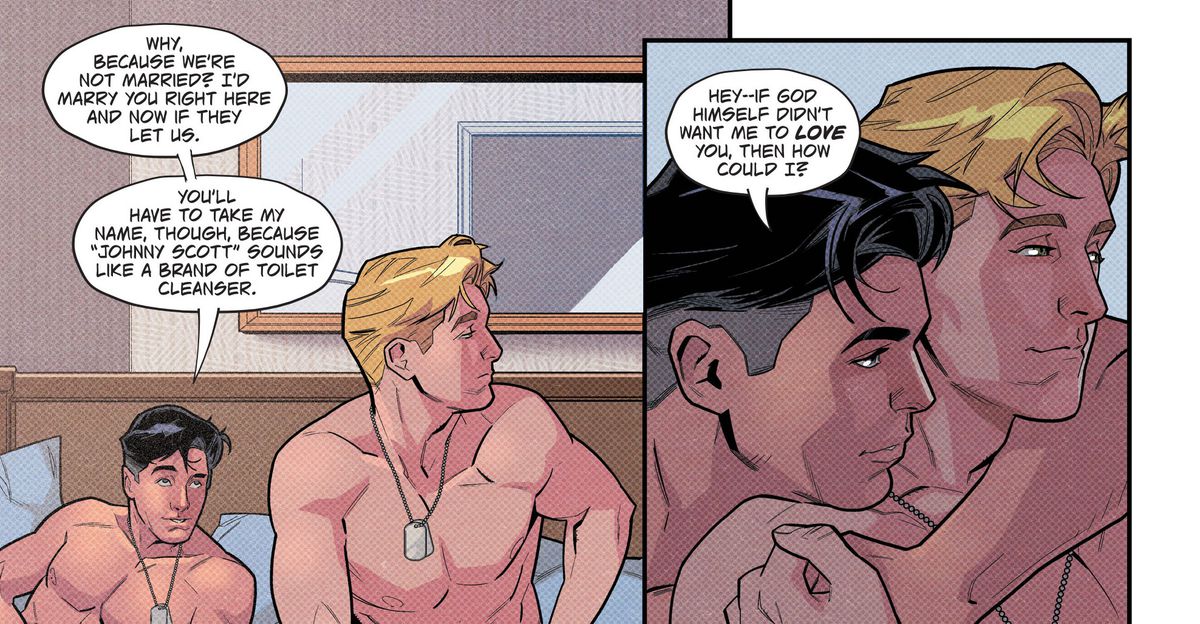
In their own DC Comics-inflected way, the issues pull no punches about midcentury queer life in the military and psychiatry. In the first issue’s opening scene, no less a personage than J. Edgar Hoover blackmails Alan by threatening to expose his sexuality. That history might seem like a strange bedfellow to a character who flies around with a power ring and a cape, but Sheridan said that the inherent optimism of superheroes — and the established fact that the dark stuff is a prelude to Alan’s much freer modern life — was maybe the only way he could write about the period in such detail.
But Sheridan also said that, to him, realism fills a gap. “There’s a place, a wonderful place!, for always-upbeat stories about heroes coming out, getting boyfriends and living happily ever after while the only adversity they face is of the super villain variety,” the writer said. “I love those stories! But they don’t, by themselves, give a complete picture of the queer experience. We’ve come up against and tackled a lot of dark, evil shit and the triumph over those hardships, both personally and publicly, is an inextricable part of queer DNA — and if we want our allies and even our rivals to know us better, we have to tell them our whole story, wherever and whenever we can.”
Still, for anyone who might be worried after the splash page at the end of issue 1, on shelves now, Sheridan readily confirmed that the story was going to turn out “OK.”
“And that’s important,” he continued, “because the message is that we’re all going to be okay! No matter how much adversity we face, no matter how many haters try and tear us down or bully us into hiding — if we stick together, we’re gonna be okay.”
- SEO Powered Content & PR Distribution. Get Amplified Today.
- PlatoData.Network Vertical Generative Ai. Empower Yourself. Access Here.
- PlatoAiStream. Web3 Intelligence. Knowledge Amplified. Access Here.
- PlatoESG. Carbon, CleanTech, Energy, Environment, Solar, Waste Management. Access Here.
- PlatoHealth. Biotech and Clinical Trials Intelligence. Access Here.
- Source: https://www.polygon.com/23930473/green-lantern-dc-comics-alan-scott-tim-sheridan
- 1
- 2020
- 32
- 33
- 40
- a
- About
- accept
- acts
- affected
- after
- Against
- age
- agenda
- aids
- Alan
- All
- allow
- also
- Amazon
- america
- an
- and
- announced
- Announcement
- anyone
- appears
- ARE
- arms
- around
- as
- ask
- asking
- At
- attacks
- attention
- back
- background
- Batman
- BE
- because
- been
- began
- being
- beloved
- Better
- beyond
- Bill
- book
- both
- brand
- bridges
- Bully
- bullying
- but
- buy
- by
- came
- CAN
- cape
- care
- carefully
- chance
- character
- characters
- Charity
- Children
- choice
- chose
- code
- combination
- come
- coming
- Common
- Companies
- complete
- confirmed
- continue
- continued
- contributions
- copies
- correct
- could
- CouRage
- cover
- created
- Creators
- Credits
- cure
- Dark
- David
- days
- dc
- death
- decision
- desk
- despite
- detail
- different
- diverse
- dna
- dog
- doing
- donate
- donating
- down
- drawn
- dumb
- earliest
- Early
- easy
- edgar
- end
- engineer
- era
- established
- even
- EVER
- everything
- evolving
- existence
- experience
- Experiences
- exponentially
- Face
- fact
- fans
- FAST
- Fear
- Feature
- felt
- Fiction
- fills
- finger
- Fire
- First
- first time
- For
- force
- Formerly
- Forward
- found
- Foundation
- Fox
- from
- front
- future
- gain
- Gaming
- gap
- Get
- getting
- give
- goes
- going
- Gold
- got
- great
- Green
- Growing
- had
- has
- Have
- he
- here
- Hero
- heroes
- High
- him
- his
- history
- honest
- hotel
- How
- HTTPS
- i
- idea
- if
- ignore
- image
- important
- in
- inception
- include
- incorporated
- inherent
- inspired
- into
- Is
- issue
- issues
- IT
- ITS
- jade
- james
- john
- johnny
- jpg
- just
- Justice
- Key
- know
- knowing
- known
- last
- lead
- left
- less
- let
- Life
- like
- Little
- Live
- living
- Long
- Look
- lot
- love
- main
- make
- Making
- man
- many
- many people
- Martin
- matter
- maybe
- me
- Media
- member
- Message
- might
- mighty
- Military
- Modern
- money
- most
- mostly
- much
- multiverse
- my
- name
- need
- New
- Newest
- no
- not
- now
- Obsidian
- of
- offer
- offered
- Okay
- oldest
- on
- One
- ones
- only
- opening
- openly
- optimism
- or
- organization.
- original
- Other
- our
- out
- over
- own
- page
- pages
- part
- participation
- Past
- People
- percentage
- period
- periods
- personal
- personally
- Philanthropy
- pick
- picture
- place
- plato
- plato data intelligence
- platodata
- platogaming
- Pledge
- policy
- Polygon
- posted
- power
- powerful
- Preview
- prices
- problems
- projects
- publicly
- Publishing
- rally
- Ranks
- read
- readily
- Ready
- reasons
- red
- relatively
- release
- remove
- research
- response
- Revealed
- right
- Ring
- rivals
- Royalty
- Said
- saw
- say
- saying
- says
- scene
- Science
- science fiction
- scott
- Secret
- see
- seem
- seen
- Series
- Share
- Silver
- since
- Sit
- SIX
- So
- Social
- social media
- Society
- someone
- something
- sometimes
- Sometimes You
- sound
- Sponsored
- stand
- stands
- start
- Stephen
- Stories
- Story
- strange
- stranger
- strike
- success
- such
- super
- superhero
- superheroes
- supporting
- sure
- Take
- taken
- talking
- tell
- tells
- than
- that
- The
- their
- Them
- themselves
- then
- These
- they
- thing
- think
- this
- those
- though
- Tim
- time
- times
- titans
- Title
- to
- together
- Toilet
- told
- too
- towards
- tried
- triumph
- true
- truth
- try
- turn
- two
- type
- universe
- until
- up
- upper
- us
- use
- variety
- version
- very
- via
- Video
- want
- was
- way
- we
- week
- when
- whenever
- while
- WHO
- whole
- whose
- with
- Work
- working
- would
- write
- writer
- written
- yet
- you
- zephyrnet

